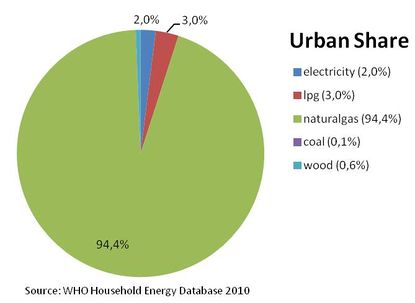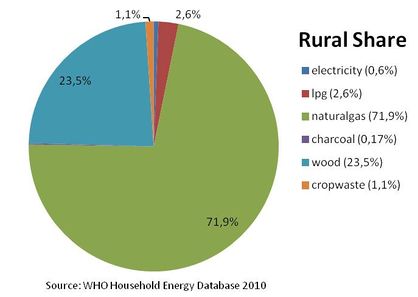Knowledge fuels change
For over a decade, Energypedia has shared free, reliable energy expertise with the world.
We’re now facing a serious funding gap.
Help keep this platform alive — your donation, big or small, truly matters!
Thank you for your support
Difference between revisions of "Uzbekistan Energy Situation"
***** (***** | *****) |
***** (***** | *****) |
||
| Line 1: | Line 1: | ||
| − | = = | + | = = |
{| style="float: right" cellspacing="0" cellpadding="0" width="400" border="1" | {| style="float: right" cellspacing="0" cellpadding="0" width="400" border="1" | ||
| Line 130: | Line 130: | ||
== Geography and Climatic Conditions == | == Geography and Climatic Conditions == | ||
| − | + | Uzbekistan is located in the heart of Central Asia. The physical environment is diverse with with flat desert covering 80% of the country and mountains in the east reaching over 4,500m high. It's climate is mainly continental with the average low temperature in Uzbekistan being 8.3°C and the average high temperature being 21.0°C <ref>CIA - The World Factbook</ref> | |
| − | |||
| − | |||
| − | |||
| − | |||
| + | Uzbekistan natural resources include natural gas, petroleum, and coal. Roughly 8.0% of Uzbekistan's land is covered by forest. The annual deforestation rate (betweeb 2005-2010) was 0.12% <ref>FAO (2011): The State of the World's Forest</ref><br> | ||
| + | == Socioeconomical Situation == | ||
| − | + | === Uzbekistan has a population of 28 million inhabitants. 63% of the population lives in rural areas and 37% in cities. === | |
| − | |||
| − | = | ||
=== Income Sources === | === Income Sources === | ||
| Line 160: | Line 156: | ||
Electrification Rate <br>National: 94.4% | Electrification Rate <br>National: 94.4% | ||
| − | + | <br> | |
==== Sources ==== | ==== Sources ==== | ||
Revision as of 08:47, 15 December 2011
| Uzbekistan | |||
| 500px-Flag of Uzbekistan svg.png |
Uzbekistan focused.png | ||
|
Capital |
Tashkent [1] | ||
|
Official Language(s) |
Uzbek; Karakalpak | ||
|
Government |
Presidential Republik | ||
|
President |
Islam Karimov | ||
|
Prime Minister |
Shavkat Mirziyoyev | ||
|
Total area in km2 |
447,400 | ||
|
Population |
28,128,600 [2] | ||
|
Rural Population |
17,721,018 | ||
|
Urban Population |
10,407,582 | ||
|
Population Density per km² |
61.4 | ||
|
GDP (nominal)(million $US) |
25712.00 | ||
|
GDP per Capita (US$) |
945.60 | ||
|
GNI per Capita (US$): |
948.30 | ||
|
Currency |
Uzbekistan som (O'zbekiston so'mi) (UZS)[3]
| ||
|
Time Zone |
UZT (UTC +5) | ||
|
Calling Code |
+998 | ||
Geography and Climatic Conditions
Uzbekistan is located in the heart of Central Asia. The physical environment is diverse with with flat desert covering 80% of the country and mountains in the east reaching over 4,500m high. It's climate is mainly continental with the average low temperature in Uzbekistan being 8.3°C and the average high temperature being 21.0°C [4]
Uzbekistan natural resources include natural gas, petroleum, and coal. Roughly 8.0% of Uzbekistan's land is covered by forest. The annual deforestation rate (betweeb 2005-2010) was 0.12% [5]
Socioeconomical Situation
Uzbekistan has a population of 28 million inhabitants. 63% of the population lives in rural areas and 37% in cities.
Income Sources
Agriculture: 44%, industry: 20%, services: 36% [6]
Energy Situation
Uzbekistan is the second largest of the Caspian gas producers, after Turkmenistan. Its abundant natural gas resources are used both for domestic consumption and export. [7]
Energy Supply
Type your text here
Electricity
Electrification Rate
National: 94.4%
Sources
Hydropower: 11.8%; Fossil fuel: 88.2% [8]
Stability
Type your text here
Energy Consumption
Type your text here
National Level
Electricity
Household Level
Fuel wood in the arid zones of Uzbekistan is often scarce as a result of deforestation and range degradation. Phasing out of energy subsidies has caused that livestock manure is used for heating and cooking, because alternative energy sources are no longer available or affordable. The country has used livestock manure in many traditional practices such as aerobic digestion (composting), anaerobic digestion (biodigesters), and as a direct application as organic fertilizer. [9]
Type your text here
Access Rate
Policy framework, laws and regulations
Type your text here
General Energy policy, Energy strategy
A National EE Strategy has been in place since 2001. Besides international initiatives a campaign has been carried out to install meters for consumers of natural gas and hot water. As a result, energy intensity of GDP decreased by 10%, from 0.96 kgoe/$ in 2000 to 0.86 kgoe/$ in 2004, still considerably high levels. There is also an Energy Efficiency Programme for the period to 2010, targeting 50% energy savings in the household and utility sectors. [10]
Important Laws and regulations
Type your text here
Specific strategies (Biomass, renewable energies, rural electrification, energy access strategy etc.)
Currently the law “On Renewable Energy Sources” has been drafted. The national strategy on the development of RES is being formulated with the assistance of UNDP. [11]
Relevant institutions and organisations
Existing projects
References
- ↑ www.Wikipedia.org
- ↑ CIA - The World Factbook
- ↑ www.Wikipedia.org
- ↑ CIA - The World Factbook
- ↑ FAO (2011): The State of the World's Forest
- ↑ CIA - The World Factbook
- ↑ IEA (2009): World Energy Outlook.
- ↑ IEA (2009): World Energy Outlook.
- ↑ Toerich K., et. al. (2008): Utilization of Agriculture Residues and Livestock wast in Uzbekistan
- ↑ INOGATE - Energy Portal: http://www.inogate.org/
- ↑ INOGATE - Energy Portal: http://www.inogate.org/





















